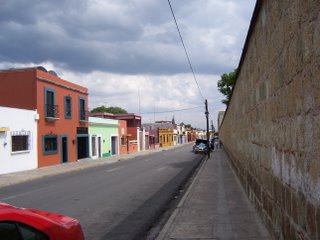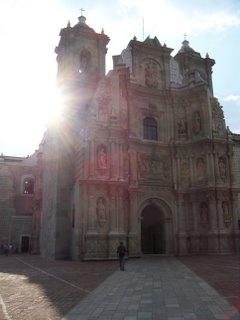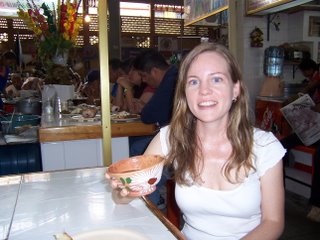
This was my entree for our favorite overall meal, at Naranja, an upscale place featuring fairly authentic (non-touristy) Oax-can cuisine, close to the main square. We matched this with a green salad that came with thin-sliced apples and a dusting of grated raw chocolate bean. Without processing, it was pure bitterness, playing the functional equivalent of black pepper, albeit with a subtle chocolate aftertaste. Our table was in a beautiful outdoor covered courtyard, surrounded by plants and birds passing through. Unfortunately, because of the teachers' protest (see below), we were the only ones there--all the other tourists were deterred.

One pleasant surprise I found was the popularity of the "torta" in local eateries. The torta is a kind of sandwich, similar to the Italian panini. The bread is grilled, making it crisp on the outside and soft on the inside. This is a chili relleno torta, with the battered, fried, and cheese-stuffed poblano, fresh tomato and avocado, and a little mayo. I got this on our first night in town, just a random choice at the only place in town that was still open, but it was surprisingly memorable.
Last but not least, I should tell you about a regional specialty called "tlayuda." It seems each sub-culture in the Latino diaspora has its own variation on the corn-based pastry stuffed with cheese and other stuff: the taco, quesedilla, pupusa, etc. Incidentally, my understanding is that the burrito is an American invention--a Mexican-American innovation on some original, as the hot dog is to the sausage. In any case, the Oax-can specialty is the tlayuda. It comes on a large (maybe 12"), flat, crispy masa pancake, slathered with beans, and topped howevery you want it. It kind of a gigantic open faced taco. I got one at the food stalls in the market, with quesillo (the regional specialty string cheese) and fresh tomato and avocado:

I must say, unfortunately, that none of these things were radically different from things we've found at L.A. restaurants like Guelaguetza. However, I was satisfied. O.C. lived up to its billing as the capital of the region with the best cuisine, and the experience was easily worth the trip and the indigestion.









